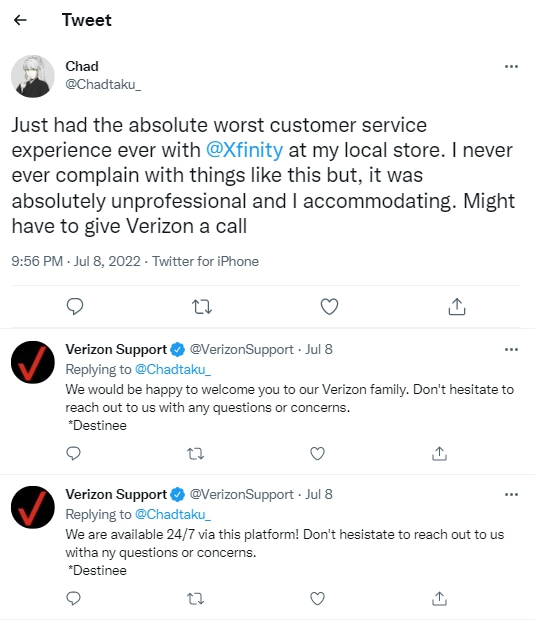Social media defines and drives today’s discourse. Social media platforms lay out unlimited opportunities for brands and businesses to interact with their market, curate their public image, and win over new customers, even loyal fans.
Why Provide Customer Service on Soсial Media?
According to statistics by Smart Insights, 58.4% of people on the planet have a social media presence, of which, over a third use social media to find out about companies, their products, services, and reputation.
A command over social media that develops brand visibility and identity positively engages an audience, and plays a part in the conversations of the day, is arguably more impactful on a company’s prospects than marketing and advertising drives.
Yet, it is a sensitive and fickle arena. Brand reputations can be riding high on good PR one day, mocked, vilified, and demonized the next. One mistake can be all it takes, and such mistakes are rarely forgotten.
According to the HubSpot survey, 68% of people express an intention to pay a little more for good customer service, and 89% will be more inclined to make a repeat purchase from a company after a pleasant customer service experience. So, effectively using social media for customer service provision must be prioritized.
Social Media Management: How Can It Go Wrong?
Overseeing a company’s social media wing can prove itself to be a demanding role for individuals, and can throw up many personal challenges, yet there are also many objective pitfalls that social media management teams can find themselves disappearing into if they aren’t mindful of their actions and haven’t learned from the mistakes made by others.
Thankfully, there is no shortage of bad social media customer service examples to learn from. Seemingly every day, twitter throws up a new scandal involving an outrageous PR and customer service screw up by a name brand.
Ignoring complaints
The point at which a consumer takes to social media to raise a grievance almost always follows a failed attempt to seek help or find a resolution to their complaint with a company directly.
Online review sites have no shortage of poor reviews of well-known companies that neglect to apologize or even acknowledge their customers’ grievances.
A consumer survey revealed that 1 in 3 people report an experience of being ignored or shut out when making inquiries or seeking a resolution with a company.
Such a course of events identifies a shortcoming with customer service provision. It is a company’s responsibility to make sure the matter stays between the customer and the business, is promptly resolved through direct channels, and hence doesn’t go public and damage your company’s image.
Yet this simple rule is broken again and again, with predictable results.
The below tweet gives an example of how a customer’s spiraling frustration can be compounded by a lack of response from a company:

Failing to back up the talk with action
You can have the most carefully curated, legally watertight complaint responses ready to go, but while they may sound attentive, present you as open and considerate to your customers, and keep your hinds covered from a litigation standpoint, they become toilet paper if you don’t back up your words with direct engagement and positive remedial action.
The below Twitter thread involving the Binance crypto exchange illustrates this point well, or rather a failure to understand it:

Obvious reliance on chatbots or automated responses
Social media fosters interaction, this is what makes it the success it has become. Obviously then, customer service over this medium needs to understand and swim downstream with this.
Companies delegating human tasks to automation is a common cause of complaint. In the context of customer service, this cost-cutting measure is almost always proven a false economy.
Although they have their place and can be used to advantageous effect, automated responses are at best a little impersonal, at worst, patronizing and insulting. How bad it can be? Well, take a look at this example of an automated response used by Verizon:

Lacking a social media strategy
A social media strategy sets the foundation upon which you build towards achieving your set goals.
Without an understanding of the different popular platforms, how best to use them, and the different demographics they appeal to, you will be, be generous, talking to yourself, or, if you’re unlucky, posting woefully inappropriate or tone-deaf content that will tar your image or land you in hot water.
Failing to engage with comments
Smart pronouncements may sound satisfying to their author, but if they don’t prompt response or engagement, then such barking at the void will be of zero practical use and simply be a waste of time.
People use social media because they want a voice and they want to be heard. When your posts are obviously automated or too generalized, the result will be that you alienate people from your company, fail to connect in any way, miss an opportunity to leverage examples of your good customer service in marketing approaches, and, inevitably, watch them choose one of your competitors.
Keep this in mind when considering customer reviews and the perspective of a customer that takes to social media to contact your company. They take the time to find you, write a considered post based on a query, complaint, or feedback, and in return for their time they get… nothing. Not even an acknowledgement.
Failing to keep pace with trends and innovations
Using social media for customer service is no longer optional. The competitive advantage of harnessing the latest technology can never be understated.
If you don’t also utilize the latest technology to your benefit in your various types of customer service operations, then you’re going to expose yourself to unnecessary failures and shortcomings; you will always be held to the highest standards of your competitors, so you must always match or exceed them.
The customer service trends outline that 70% of customer service operations are relying up to 25% more on live chat and live messaging to deal with inquiries, and 66% are focusing up to 25% more on AI chatbots and automated services.
Clearly, staying in touch with the latest such industry and social media marketing trends is vital.
Everything you say sounds like a sales pitch
While taking advantage of every customer interaction in such a way is simply good business practice, abandoning subtlety or any attempt to finesse the sale can be a problem.
One common mistake social media managers often make is that they come across as relentlessly sales oriented, in which every customer service situation is, quite transparently, treated as an opportunity to funnel the customer into another sale.
If your customer service interactions on social media give off this vibe, then you’ll find people far less likely to see the point in engaging with you.
What Can You Do? Measures and Preventive Action
Good social media customer service responses
While rare compared to the abundant examples of when things go wrong, there are instances of good social media customer service responses to be found.
Examples of common pitfalls and how they have been overcome or avoided are worth investigating, as many will be applicable to your business and situations it could find itself in.
Keep tabs on what your public is saying about you
A key role of social media customer service is maintaining an awareness of public image on social media and the conversations that their company name is being brought up in.
This is a demanding role, a full-time job, so any organization that treats this aspect with the requisite seriousness will have a dedicated position or team of individuals trained specifically to manage their presence on several social media platforms at once.
Not only must this team have an ear to the ground for notifications, mentions, reviews et al., but they also need to be savvy to cultural trends, sensitivities, and taboos and understand how to respond to negative comments assertively, yet with clarity, appropriateness, and tact.
Recovering from social media mistakes
News travels fast. Blunders are big news and, yes, people will jump on them and you will be made a fool of. Yet, how you respond to such bloopers can have more bearing on the outcome on your reputation than the misstep itself.
#1 Take action right away, but don’t immediately go on the defensive
The longer your faux-pas are hanging out in public view like dirty laundry, the more attention it will get, the more people will talk, and inevitably the jokes and memes will follow.
First, acknowledge the screw-up. Hold your hands in the air and admit the mistake. Don’t just delete, delete, delete and hope for the best.
Understand why the post caused the reaction it did. Who did it upset or offend and why? Or if it simply made you look stupid and didn’t provoke a response because it was insensitive or tone-deaf, roll with it and show you have a sense of humor.
#2 Clean-up
Remove the content in question, and replace it with an apology and a clear, formal explanation that communicates that you understand why the post was poorly judged, that you understand the offense it has caused, and what (if necessary) action you will take to put things right.
#3 Don’t just put a band-aid on the wound, invest in finding out why it happened
How did you find yourself in this situation? What oversights and preventable actions led to it taking place? Figure this out and save your customer service team from the emergency firefighting duties.
Your customer service team needs to stay informed about what’s happening and be savvy enough for it to click when your social media postings may not be construed in the best light if they clash with current events.
Always run social media postings through several points of the audit before sending them live. What seems innocent and family-friendly to one mind may throw up obvious red flags in another.
#4 Always stay respectable. Always stay professional
Business and emotions are not a good mix. Your customer service staff should have the training and humor to deflect any jarring or personal attacks delivered by a rude, heated customer.
A calm, objective and professional manner is the way forward in these situations, with a little sympathy and verbal recognition of the customers’ situation; always remember you are dealing with real people, put yourself in their shoes and visualize the situation from their perspective.
Crucially, always maintain an open dialog and don’t cut off the customer or leave them hanging when they feel the situation is unresolved.
How to Respond to Complaints on Social Media?
Research has revealed that ignoring your customers’ comments on your social media channels contributes to a 15% churn rate. So why would you neglect this aspect of business if the consequences are so stark?
Customer service that incorporates social media seriously needs to go beyond a reactive role.
Your customer service remit must include an organized effort to keep an eye on your social media channels to check the engagement trends and to keep abreast of complaints so you can be attentive and respond to them promptly.
In instances where a critical comment shows up, neither ignore it, dismiss it with an aloof, condescending message, make an implausible, knee-jerk excuse, or, god forbid, reply with a pre-written or automated response.
Be attentive to and engage with online reviews
Reviews are useful, very useful. Not only do they provide invaluable feedback on how you are doing, but they also provide a window into the wants and needs of your market, and from a customer-focused perspective, can inform your strategy going forward.
The absolute best way to encourage the most helpful feedback from your customers, that is, open, honest, constructive criticism, is to not only be present, but be active, engage, and get a dialog going when addressing reviews.
Criticism always presents an opportunity to gain experience, understand your relationship with your customers a bit better, and grow, and each negative comment you get should be seen as a door to this opportunity to improve.
Engage with comments on your social media, positive comments too
Not only is it imperative that you are active on your social media (regular updates are a must), but you must also always take the time to thoughtfully respond to comments people leave on your social media channels.
As previously mentioned, not only is a person much more likely to consider your company over your competition if you respond to their comments on social media but doing so also increases engagement and opportunities for you to create a lasting positive impression.
To summarize, a well-run customer service operation that is on the ball and sensitive to the needs of its public will have the following aspects covered:
• Knowing which social media platform/s best complement your business strategy
• A sharp eye on social media engagement, mentions, reviews, etc.
• Promptness and professionalism in responses
• Understanding tone, humor, and appropriateness when engaging
Always be mindful about what you are putting your company name behind
Consider every post and message objectively, and get a second opinion, at least, before committing to the public sphere. It’s far smarter to take precautions than have to clean up the mess afterward.
Customer Loyalty Is an Investment in the Future of Your Business
The quality of customer service you provide on your social media is the single most determining factor in establishing and developing excellent relationships with your customers.
Attentiveness, regular engagement, and a keen sense of timing will see you foster a strong connection between you and your market.
Customer loyalty is everything in the fast chatter of the make-or-break court of social media. Happy and faithful customers solidify and grow your business, so take your action across social media seriously, and use it as an opportunity to excel and show you are a cut above the rest.






